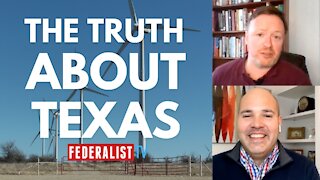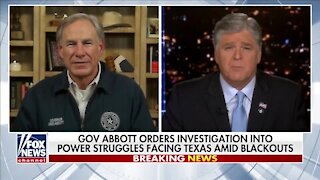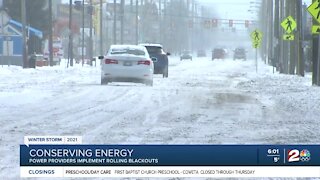Premium Only Content

The TRUTH About Texas and Midwest Power Crisis /Blackouts
Order No. 202-21-1
Pursuant to the authority vested in the Secretary of Energy by section 202(c) of
the Federal Power Act (FPA), 16 U.S.C. § 824a(c), and section 301(b) of the Department
of Energy Organization Act, 42 U.S.C. § 7151(b), and for the reasons set forth below, I
hereby determine that an emergency exists in Texas due to a shortage of electric energy, a
shortage of facilities for the generation of electric energy, and other causes, and that
issuance of this Order will meet the emergency and serve the public interest.
On February 14, 2021, the Electric Reliability Council of Texas (ERCOT), the
Independent System Operator (ISO) whose service territory includes 90 percent of the
electric customers in the state of Texas, filed a Request for Emergency Order Under
Section 202(c) of the Federal Power Act (Application) with the United States Department
of Energy (Department) “to preserve the reliability of bulk electric power system.”
ERCOT is in the beginning stages of an unprecedented cold weather event
brought on by a rare, southward excursion of the jet stream into the South Central United
States. Temperatures for Sunday and Monday in many parts of Texas are forecasted to
drop well below the lowest temperatures experienced in several decades, and abnormally
low temperatures are expected to persist for several more days. This weather event is
expected to result in record winter electricity demand that will exceed even ERCOT’s
most extreme seasonal load forecasts.
On February 12, 2021, Greg Abbott, the Governor of the State of Texas declared
a state of disaster in all 254 Texas counties due to severe weather posing an “imminent
threat of widespread and severe property damage, injury, and loss of life due to prolonged
freezing temperatures, heavy snow, and freezing rain statewide.” On the morning of
February 14, ERCOT issued a system-wide conservation notice addressing the expected
system emergency and describing steps that homeowners and businesses can take to
reduce system demand.1
ERCOT has also worked with state agencies to take measures
that maximize generation availability in Texas. For example, on February 12, the
Railroad Commission of Texas issued an Emergency Order pursuant to Texas Utilities
Code affecting the gas utility systems in the state. The order specified increasing the
priority of gas supplies to ERCOT generators. ERCOT’s application also noted that the
“Texas Commission on Environmental Quality has indicated that it will provide
enforcement discretion to generators in the ERCOT region that may exceed state
emissions requirements during emergency conditions.”
According to ERCOT, the measures taken by ERCOT and other state agencies
may not prove sufficient to avoid rotating outages of as much as 4,000 MW. Moreover,
1 ERCOT, Grid Operator Requests Energy Conservation for System Reliability,
www.ercot.com/news/releases/show/225151.
Department of Energy Order No. 202-21-1
Page 2 of 4
ERCOT has been alerted that numerous generation units will be unable to operate at full
capacity without violating federal air quality or other permit limitations.
ERCOT requests that the Secretary issue an order immediately, effective February
14, 2021 through February 19, 2021, authorizing “the provision of additional energy from
all generation units subject to emissions or other permit limits” in the ERCOT region.
The generating units (Specified Resources) that this Order pertains to are listed on the
Order 202-21-1 Resources List, as described below.
Given the emergency nature of the expected load stress, the responsibility of
ERCOT to ensure maximum reliability on its system, and the ability of ERCOT to
identify and dispatch generation necessary to meet the additional load, I have determined
that additional dispatch of the Specified Resources is necessary to best meet the
emergency and serve the public interest for purposes of FPA section 202(c). Because the
additional generation may result in a conflict with environmental standards and
requirements, I am authorizing only the necessary additional generation, with reporting
requirements as described below.
FPA section 202(c)(2) requires the Secretary of Energy to ensure that any 202(c)
order that may result in a conflict with a requirement of any environmental law be limited
to the “hours necessary to meet the emergency and serve the public interest, and, to the
maximum extent practicable,” be consistent with any applicable environmental law and
minimize any adverse environmental impacts. ERCOT anticipates that this Order may
result in exceedance of emissions of sulfur dioxide, nitrogen oxide, mercury, and carbon
monoxide emissions, as well as wastewater release limits. To minimize adverse
environmental impacts, this Order limits operation of dispatched units to the times and
within the parameters determined by ERCOT for reliability purposes.
Based on my determination of an emergency set forth above, I hereby order:
A. From February 14, to February 19, 2021, in the event that ERCOT determines that
generation from the Specified Resources is necessary to meet the electricity demand that
ERCOT anticipates in Texas during this event, I direct ERCOT to dispatch such unit or
units and to order their operation only as needed to maintain the reliability of the power
grid in the ERCOT region when the demand on the ERCOT system exceeds expected
energy and reserve requirements. Specified Resources are those natural gas, coal, or
distillate fuel oil generating units set forth on the Order 202-21-1 Resource List, subject
to updates directed here and as described in paragraph D, which the Department shall
post on www.energy.gov. ERCOT is directed to update Exhibit A to its Application with
the anticipated category of environmental impact (i.e. sulfur dioxide, nitrogen oxide,
mercury, carbon monoxide emissions, wastewater release, other air pollutants) by 21:00
Central Standard Time on February 15, 2021.
B. To minimize adverse environmental impacts, this Order limits operation of dispatched
units to the times and within the parameters determined by ERCOT for reliability
purposes. Consistent with good utility practice, ERCOT shall exhaust all reasonably and
Department of Energy Order No. 202-21-1
Page 3 of 4
practically available resources, including available imports, demand response, and
identified behind-the-meter generation resources selected to minimize an increase in
emissions, to the extent that such resources provide support to maintain grid reliability,
prior to dispatching the Specified Resources. ERCOT shall provide a daily notification to
the Department reporting each generating unit that has been designated to use the
allowance and operated in reliance on the allowances contained in this Order.
In furtherance of the foregoing and, in each case, subject to the exhaustion of all available
imports, demand response, and identified behind-the-meter generation resources selected
to minimize an increase in emissions available to support grid reliability:
(i) with respect to any Specified Resource that is an ERCOT Generation
Resource or Settlement Only Generator whose operator notifies ERCOT
that the unit is unable, or expected to be unable, to produce at its
maximum output due to an emission or effluent limit in any federal
environmental permit, ERCOT shall ensure that such Specified Resource
is only allowed to exceed any such limit during a period for which
ERCOT has declared an Energy Emergency Alert (EEA) Level 2 or Level
3. This incremental amount of restricted capacity would be offered at a
price no lower than $1,500/MWh. Once ERCOT declares that such an
EEA Level 2 or Level 3 event has ended, the unit is required to
immediately return to operation within its permitted limits; and
(ii) with respect to any Specified Resource that is an ERCOT Generation
Resource whose operator notifies ERCOT that the unit is offline or would
need to go offline due to an emission or effluent limit in any federal
environmental permit, and to which ERCOT has issued a Reliability Unit
Commitment (RUC) instruction, the operator may make all of the unit’s
capacity available to ERCOT for dispatch during a period for which
ERCOT has declared an EEA Level 2 or Level 3. This incremental
amount of restricted capacity would be offered at a price no lower than
$1,500/MWh. Once ERCOT declares that such an EEA Level 2 or Level 3
event has ended, the unit is required to immediately return to operating at
a level below the higher of its minimum operating level or the maximum
output allowable under the permitted limit.
In the event ERCOT identifies the need to exceed other relevant environmental
permitting levels, ERCOT shall specifically identify such permitting levels and DOE will
consider ERCOT’s request in good faith.
C. All entities must comply with environmental requirements to the maximum extent
necessary to operate consistent with the emergency conditions. This Order does not
provide relief from an entity’s obligations to purchase allowances for emissions that
occur during the emergency condition or to use other geographic or temporal flexibilities
available to generators.
Department of Energy Order No. 202-21-1
Page 4 of 4
D. In the event that ERCOT identifies additional generation units that it deems necessary
to operate in excess of federal environmental permitting limits in order to maintain the
reliability of the power grid in the ERCOT region when the demand on the ERCOT
system exceeds expected energy and reserve requirements, including any such entity to
which ERCOT intends to issue a Reliability Unit Commitment (RUC), ERCOT shall
provide prompt written notice to the Department of Energy at AskOE@hq.doe.gov
identifying in an updated Exhibit A to its Application such additional generation units,
the fuel type of such unit, and the anticipated category of environmental impact, at 9:00
Central Standard Time or 21:00 Central Standard Time, whichever follows closest in
time to the unit identification by ERCOT to the greatest extent feasible. Such additional
generation unit shall be deemed a Specified Resource for the purpose of this Order for the
hours prior to the required written notice to the Department, and ERCOT may dispatch
such additional generation units, provided that if the Department of Energy notifies
ERCOT that its does not approve of such generation unit being designated as a Specified
Resource, such generation unit shall not constitute a Specified Resource upon notification
from the Department. The Department shall post an updated Order 202-21-1 Resource
List as soon as practicable following notification from ERCOT under this paragraph.
E. ERCOT shall provide such additional information regarding the environmental
impacts of this Order and its compliance with the conditions of this Order, in each case as
requested by the Department of Energy from time to time. By March 1, 2021, ERCOT
shall report all dates between February 14, 2021, and February 19, 2021, on which the
Specified Resources were operated, the hours of operation, and exceedance of permitting
limits, including sulfur dioxide, nitrogen oxide, mercury, carbon monoxide, and other air
pollutants, as well as exceedances of wastewater release limits. ERCOT shall submit a
final report by March 31, 2021, with any revisions to the information reported on March
1, 2021. In addition, ERCOT shall provide information to the Department quantifying
the net revenue associated with generation in excess of environmental limits accruing to
non-RUC units in connection with orders issued by the Department pursuant to Section
202(c) of the Federal Power Act.
F. This Order shall be effective upon its issuance, and shall expire at 11:59 p.m. Central
Standard Time Friday, February 19, 2021, with the exception of the reporting
requirements in paragraph E. Renewal of this Order, should it be needed, must be
requested before this Order expires.
Issued in Washington, D.C. at 8:51 PM Eastern Standard Time on this 14th day of
February, 2021.
David Huizenga
Acting Secretary of Energy
-
 7:54
7:54
NEWSMAX
3 years agoTEXAS NOW FACING WATER CRISIS AFTER POWER FAILURE
2.55K21 -
 4:11
4:11
No Spin News with Bill O'Reilly
3 years agoThe Truth About the Texas Freeze
24.5K122 -
 33:07
33:07
The Federalist
3 years agoThe Truth Behind The Texas Blackouts: It's Basic Math
2.1K18 -
 6:14
6:14
Sean Hannity
3 years agoTexas governor orders investigation into power struggles, blackouts
14.3K -
 2:46
2:46
KJRH
3 years agoPower providers implement rolling blackouts
482 -
 15:07
15:07
Bible Logics
3 years ago $1.01 earnedTruth about Creation 1.0
2.86K6 -
 3:49:06
3:49:06
Alex Zedra
16 hours agoLIVE! New Game | Nuclear Nightmare
102K13 -
 25:08
25:08
MYLUNCHBREAK CHANNEL PAGE
1 day agoUnder The Necropolis - Pt 2
284K76 -
 1:45:59
1:45:59
Spittin' Chiclets
1 day agoCanadian Chokejob - Game Notes Live From Chicago - 12.28.2024
262K32 -
 9:18
9:18
Space Ice
1 day agoThe Guyver - Alien Bug Suits, Exploding Dragons, & Mark Hamill - Weirdest Movie Ever
167K27